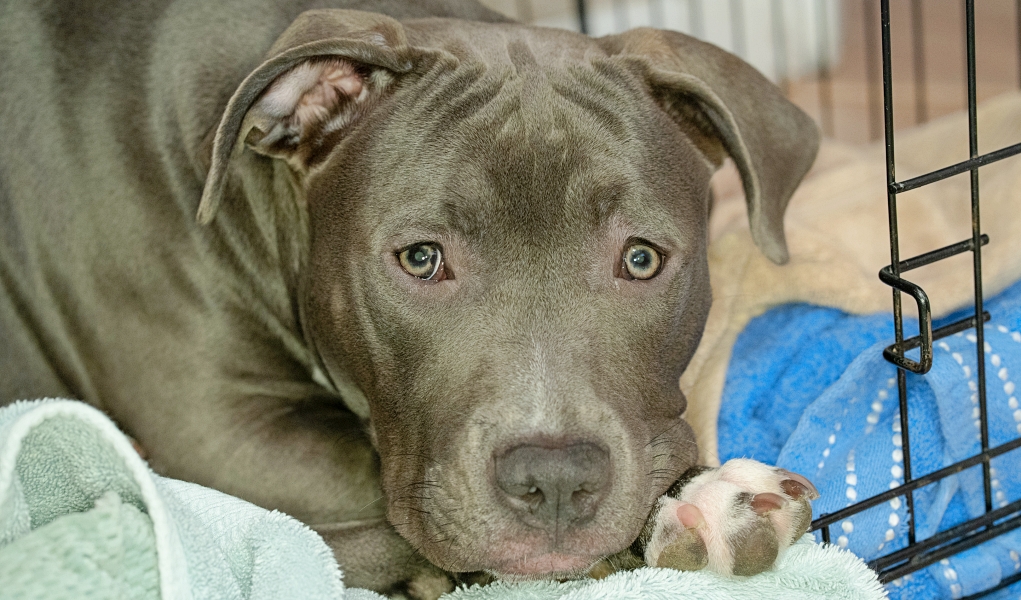It is frustrating to come home after a long day of work to find that your dog has peed in her crate. You have to clean the crate, the bedding, and sometimes even your dog.
Crate training a dog isn't easy, but there are some simple tricks that you can use to help if your dog pees in the crate.
Sometimes, peeing in the crate can be the result of a medical issue, like a urinary tract infection.
It's more likely due to a non-medical issue or simply because your dog is young and cannot hold her bladder for long periods of time.
Non-medical issues that could cause your pup to start peeing in her crate could include:
- a new environment
- a schedule change
- a major change in your dog's life (like a new pet or new person in the home)
If you have a young puppy, peeing in the crate probably isn't anything to worry about.
However, if you have an adult dog that has been house/crate trained for a while, you'll want to rule out the possibility of an underlying health condition before doing anything else.
Dog Pees In Crate: What To Do
The first thing that you need to understand is that crate training is NOT a replacement for potty training.
You can't just leave your dog in a crate all day instead of taking the time to house-train your pet.
Whether you have a new puppy or you've adopted an older dog that hasn't been housebroken, you need to work on training before leaving them in a crate.
Potty training your dog isn't something that is going to happen overnight.
You need to put in the time to properly house-train your pet before you can expect to leave him in a crate for an extended period of time. For tips on potty training your pooch, check out these helpful resources:
- 8 Basic Tips for Potty Training A Puppy
- 7 Reasons You're Failing at Housebreaking A Puppy (and how to fix them)
- 20 Puppy Potty Training Hacks and Tricks
Once your pet is properly potty trained, he should be able to stay in his crate for a reasonable amount of time without having an accident.
If your dog still pees in the crate, try these quick-fix tips to solve the problem.
1. Don't leave him too long
Dogs should never be left in a crate all day. While the maximum amount of time should not be more than 6-8 hours, most dog trainers recommend the 3-hour rule.
After 3 hours of being in a crate, boredom will set in and your dog may begin to get antsy. If at all possible, you should have someone let your dog out for a crate break about every 3 hours.
Young puppies, small breeds, and dogs with health conditions will need more frequent crate breaks.
In this case, you may need to hire a pet sitter or dog walker to let your dog out for more frequent potty breaks.
2. You may need to adjust your schedule
If your dog pees in the crate often, it's likely that you need to adjust your daily schedule to better meet your pet's needs.
You should have a crate training schedule that your dog is familiar with, and then set strict times for feeding, sleeping, and bathroom breaks.
A feeding schedule, in particular, is very helpful when trying to get your dog to go to the bathroom regularly.
Dogs will typically need to use the bathroom within 30 minutes of eating or drinking. Take advantage of this predictable behavior.
Feed your dog at least 1 hour before leaving the house for the day. Allow him to drink water, but give him multiple chances to use the bathroom outside before you leave.
 3. Crate size matters
3. Crate size matters
It's important to pick the right dog crate size. Measure your pet and choose a crate that's large enough for her to stand up and turn around but not any bigger.
When the kennel is too big, there's a good chance your dog is using one end to eliminate it while sleeping on the other end.
If you have a large breed puppy and you don't want to spend money on multiple crates, purchase one with a removable divider.
As your puppy grows, the crate can grow with him. When your dog reaches full size, you can remove the divider, and she will have access to the entire crate.
4. Exercise is important
Did you know that exercise stimulates a dog's need to “go”? It will also burn off excess energy and make him more apt to sleep while he's in his crate waiting for you to come home.
Play fetch, go for a walk, or take a trip to the dog park before you leave for the day. Your dog will be more likely to go to the bathroom outside, and she'll be tired during her time in the crate.
5. Crate anxiety is a real problem
Some dogs just cannot handle being crated. Crate anxiety is a real problem, and if your dog suffers from this condition, you may need to look into other options.
After you place your pet in a crate, watch out for signs of stress. If any distress is present, that often leads to peeing and pooping uncontrollably.
If your dog suffers from this condition, you won't be able to crate her. You may be able to leave your pet home alone after some additional house training.
You may also need to look into doggy daycare options or hire a pet sitter to watch your canine companion while you're not home.
It's frustrating when your dog pees in the crate, but it's usually a very simple issue to correct.
If none of the above strategies stop the accidents, it's important to consult your veterinarian to make sure there isn't an underlying issue causing the problem.













